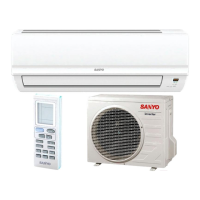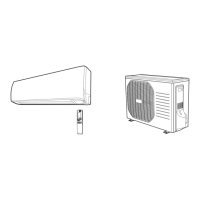Do you have a question about the Sanyo SAP-KRV124EHDX and is the answer not in the manual?
Covers essential requirements for safe and efficient air conditioner operation.
Details safety measures for wiring, transport, installation, servicing, and refrigerant handling.
Provides detailed technical specifications for indoor and outdoor units.
Lists specifications for key components like PCB, motors, and fans.
Details specifications for sensors and other unit components.
Illustrates the refrigerant circuit for cooling, heating, and defrosting cycles.
Displays cooling and heating performance based on indoor/outdoor temperatures.
Shows airflow distance characteristics for cooling and heating modes.
Provides electrical ratings including running amperes and power input.
Presents wiring diagrams for indoor and outdoor units.
Guides on selecting appropriate locations for unit installation.
Specifies wiring requirements and recommendations.
Recommends optimal placement for the remote control unit.
Details the procedure for conducting a post-installation test run.
Explains how to remove and reinstall the indoor unit's front grille.
Describes how to set remote control addresses to prevent signal interference.
Provides instructions for servicing the unit's drain hose.
Details the procedure for accessing and removing the electrical component box.
Explains how to remove and replace the panel motor.
Provides steps for removing and installing the drain pan assembly.
Describes how to remove the negative ion generator unit.
Details the process for removing and installing the fan motor.
Explains how to safely remove the fan assembly.
Covers disconnecting and connecting positive connectors for the outdoor unit.
Describes various operating modes like Auto, Dry, and Fan only.
Explains safety features like overload, freeze prevention, and compressor control.
Outlines critical safety measures before starting troubleshooting procedures.
Details how to use the unit's self-diagnostic feature to identify faults.
Guides on diagnosing issues with indoor and outdoor fan motors.
Addresses noise malfunctions and electromagnetic interference problems.
Helps resolve issues with the front panel's functionality.
Guides on diagnosing problems with the panel motor.
Explains how to measure insulation resistance for electrical safety checks.
Details how to check fuse continuity using a multimeter.
Highlights critical safety measures and procedures for R410A refrigerant.
Describes the properties, composition, and safety aspects of R410A.
Lists essential checks and precautions before performing service on R410A systems.
Lists specialized tools required for R410A refrigerant handling and service.
Provides procedures for diagnosing and replacing a malfunctioning compressor.
Details steps for detecting, repairing, and recharging refrigerant leaks.
Explains how to add refrigerant, including important safety warnings.
Discusses considerations for using R410A with existing systems or tubing.
Covers essential requirements for safe and efficient air conditioner operation.
Details safety measures for wiring, transport, installation, servicing, and refrigerant handling.
Provides detailed technical specifications for indoor and outdoor units.
Lists specifications for key components like PCB, motors, and fans.
Details specifications for sensors and other unit components.
Illustrates the refrigerant circuit for cooling, heating, and defrosting cycles.
Displays cooling and heating performance based on indoor/outdoor temperatures.
Shows airflow distance characteristics for cooling and heating modes.
Provides electrical ratings including running amperes and power input.
Presents wiring diagrams for indoor and outdoor units.
Guides on selecting appropriate locations for unit installation.
Specifies wiring requirements and recommendations.
Recommends optimal placement for the remote control unit.
Details the procedure for conducting a post-installation test run.
Explains how to remove and reinstall the indoor unit's front grille.
Describes how to set remote control addresses to prevent signal interference.
Provides instructions for servicing the unit's drain hose.
Details the procedure for accessing and removing the electrical component box.
Explains how to remove and replace the panel motor.
Provides steps for removing and installing the drain pan assembly.
Describes how to remove the negative ion generator unit.
Details the process for removing and installing the fan motor.
Explains how to safely remove the fan assembly.
Covers disconnecting and connecting positive connectors for the outdoor unit.
Describes various operating modes like Auto, Dry, and Fan only.
Explains safety features like overload, freeze prevention, and compressor control.
Outlines critical safety measures before starting troubleshooting procedures.
Details how to use the unit's self-diagnostic feature to identify faults.
Guides on diagnosing issues with indoor and outdoor fan motors.
Addresses noise malfunctions and electromagnetic interference problems.
Helps resolve issues with the front panel's functionality.
Guides on diagnosing problems with the panel motor.
Explains how to measure insulation resistance for electrical safety checks.
Details how to check fuse continuity using a multimeter.
Highlights critical safety measures and procedures for R410A refrigerant.
Describes the properties, composition, and safety aspects of R410A.
Lists essential checks and precautions before performing service on R410A systems.
Lists specialized tools required for R410A refrigerant handling and service.
Provides procedures for diagnosing and replacing a malfunctioning compressor.
Details steps for detecting, repairing, and recharging refrigerant leaks.
Explains how to add refrigerant, including important safety warnings.
Discusses considerations for using R410A with existing systems or tubing.
| Brand | Sanyo |
|---|---|
| Model | SAP-KRV124EHDX |
| Category | Air Conditioner |
| Language | English |












